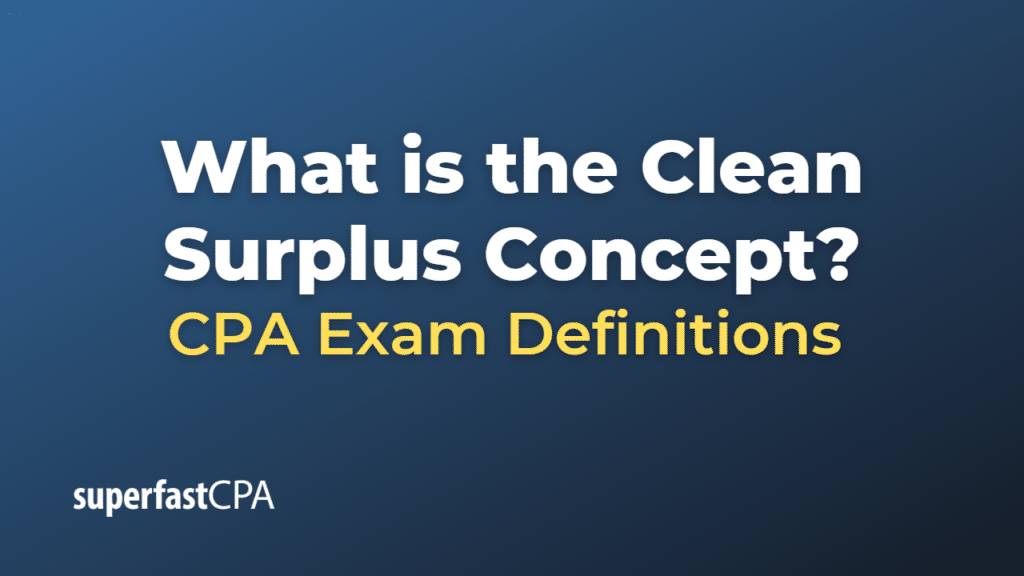Clean Surplus Concept
The clean surplus concept is an accounting and valuation approach that focuses on separating a company’s operating performance from its financing activities. This concept is particularly useful for equity valuation and financial analysis, as it allows analysts to better understand the sources of a company’s earnings and the efficiency of its operations.
Under the clean surplus concept, the change in a company’s book value (or shareholders’ equity) during a given period is assumed to be the result of two components:
- Retained earnings: This represents the portion of net income that the company retains (i.e., does not distribute as dividends) and reinvests in its business. Retained earnings are considered part of the company’s operating performance, as they are generated through the company’s core business activities.
- Other comprehensive income (OCI): This represents the changes in shareholders’ equity that are not related to net income or dividends. OCI includes items such as unrealized gains or losses on available-for-sale securities, foreign currency translation adjustments, and changes in the value of certain financial instruments due to changes in market prices. These items are typically considered non-operating in nature, as they result from financing activities or other events that are not directly related to the company’s core business.
By separating the change in book value into these two components, the clean surplus concept allows analysts to focus on the company’s operating performance (as reflected in retained earnings) while also taking into account the impact of financing activities and other non-operating events (as reflected in OCI).
The clean surplus concept can be used in various valuation models, such as the residual income model or the clean surplus return on equity (ROE) model, which emphasize the importance of operating performance and the efficient use of capital in generating shareholder value. By focusing on the company’s core business activities and isolating the impact of financing decisions, the clean surplus concept can help analysts obtain a clearer picture of a company’s true economic performance and its ability to create value for its shareholders.
Example of the Clean Surplus Concept
Let’s consider a fictional company, “GreenEnergy Corp.” Below are some key financial figures for the company:
- Net income for the year: $10 million
- Dividends paid: $2 million
- Retained earnings at the beginning of the year: $40 million
- Unrealized gain on available-for-sale securities: $3 million
- Foreign currency translation adjustment: -$1 million
Using the clean surplus concept, we can separate the company’s operating performance from its financing activities as follows:
- Calculate retained earnings for the year:
Retained earnings = Net income – Dividends
Retained earnings = $10 million – $2 million
Retained earnings = $8 million - Calculate other comprehensive income (OCI) for the year:
OCI = Unrealized gain on available-for-sale securities + Foreign currency translation adjustment
OCI = $3 million – $1 million
OCI = $2 million - Calculate the change in book value (shareholders’ equity) for the year:
Change in book value = Retained earnings + OCI
Change in book value = $8 million + $2 million
Change in book value = $10 million - Calculate the ending retained earnings and book value:
Ending retained earnings = Beginning retained earnings + Retained earnings for the year
Ending retained earnings = $40 million + $8 million
Ending retained earnings = $48 million
Ending book value = Beginning book value + Change in book value
(Assuming the beginning book value is $100 million)
Ending book value = $100 million + $10 million
Ending book value = $110 million
In this example, the clean surplus concept allows us to separate GreenEnergy Corp.’s operating performance, as reflected in its retained earnings, from its financing activities and other non-operating events, as reflected in its OCI. This separation can help analysts better understand the sources of the company’s earnings and the efficiency of its operations, ultimately providing valuable insights for equity valuation and financial analysis.













